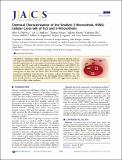| dc.contributor.author | Filipovic, Milos R. | |
| dc.contributor.author | Miljkovic, Jan Lj. | |
| dc.contributor.author | Nauser, Thomas | |
| dc.contributor.author | Royzen, Maksim | |
| dc.contributor.author | Klos, Katharina | |
| dc.contributor.author | Shubina, Tatyana | |
| dc.contributor.author | Koppenol, Willem H. | |
| dc.contributor.author | Lippard, Stephen J. | |
| dc.contributor.author | Ivanović-Burmazović, Ivana | |
| dc.date.accessioned | 2013-06-06T20:17:11Z | |
| dc.date.available | 2013-06-06T20:17:11Z | |
| dc.date.issued | 2012-07 | |
| dc.date.submitted | 2012-01 | |
| dc.identifier.issn | 0002-7863 | |
| dc.identifier.issn | 1520-5126 | |
| dc.identifier.uri | http://hdl.handle.net/1721.1/79076 | |
| dc.description.abstract | Dihydrogen sulfide recently emerged as a biological signaling molecule with important physiological roles and significant pharmacological potential. Chemically plausible explanations for its mechanisms of action have remained elusive, however. Here, we report that H2S reacts with S-nitrosothiols to form thionitrous acid (HSNO), the smallest S-nitrosothiol. These results demonstrate that, at the cellular level, HSNO can be metabolized to afford NO+, NO, and NO– species, all of which have distinct physiological consequences of their own. We further show that HSNO can freely diffuse through membranes, facilitating transnitrosation of proteins such as hemoglobin. The data presented in this study explain some of the physiological effects ascribed to H2S, but, more broadly, introduce a new signaling molecule, HSNO, and suggest that it may play a key role in cellular redox regulation. | en_US |
| dc.description.sponsorship | Friedrich-Alexander-Universität Erlangen-Nürnberg (Intermural grant from Emerging Field Initiative: Medicinal Redox Inorganic Chemistry) | en_US |
| dc.description.sponsorship | National Science Foundation (U.S.) | en_US |
| dc.description.sponsorship | National Institutes of Health (U.S.) (Postdoctoral Fellowship) | en_US |
| dc.language.iso | en_US | |
| dc.publisher | American Chemical Society | en_US |
| dc.relation.isversionof | http://dx.doi.org/10.1021/ja3009693 | en_US |
| dc.rights | Article is made available in accordance with the publisher's policy and may be subject to US copyright law. Please refer to the publisher's site for terms of use. | en_US |
| dc.source | American Chemical Society | en_US |
| dc.title | Chemical Characterization of the Smallest S-Nitrosothiol, HSNO; Cellular Cross-talk of H₂S and S-Nitrosothiols | en_US |
| dc.type | Article | en_US |
| dc.identifier.citation | Filipovic, Milos R., Jan Lj. Miljkovic, Thomas Nauser, et al. 2012Chemical Characterization of the Smallest S -Nitrosothiol, HSNO; Cellular Cross-talk of H₂S and S -Nitrosothiols. Journal of the American Chemical Society 134(29): 12016–12027. | en_US |
| dc.contributor.department | Massachusetts Institute of Technology. Department of Chemistry | en_US |
| dc.contributor.mitauthor | Lippard, Stephen J. | en_US |
| dc.contributor.mitauthor | Royzen, Maksim | en_US |
| dc.relation.journal | Journal of the American Chemical Society | en_US |
| dc.eprint.version | Final published version | en_US |
| dc.type.uri | http://purl.org/eprint/type/JournalArticle | en_US |
| eprint.status | http://purl.org/eprint/status/PeerReviewed | en_US |
| dspace.orderedauthors | Filipovic, Milos R.; Miljkovic, Jan Lj.; Nauser, Thomas; Royzen, Maksim; Klos, Katharina; Shubina, Tatyana; Koppenol, Willem H.; Lippard, Stephen J.; Ivanović-Burmazović, Ivana | en_US |
| dc.identifier.orcid | https://orcid.org/0000-0002-2693-4982 | |
| mit.license | PUBLISHER_POLICY | en_US |
| mit.metadata.status | Complete | |
